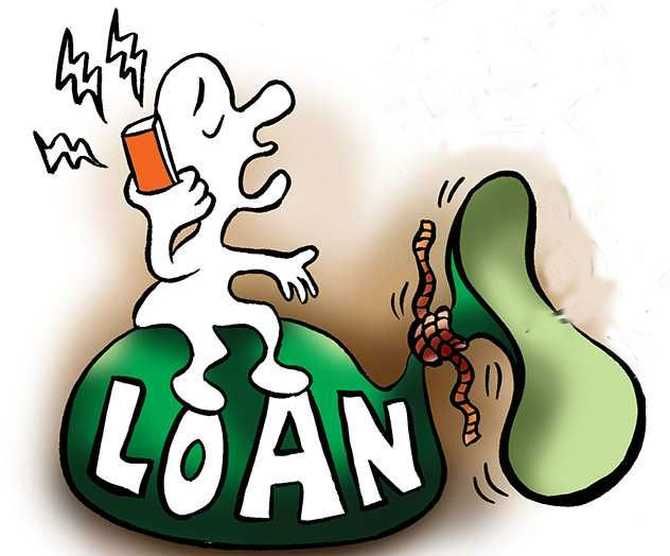 | « Back to article | Print this article |
'If the interest rate on bank deposits is linked to any external benchmark, it would jeopardise the banks' fund-raising ability.
'Interest rates on small savings schemes are likely to be reduced very shortly, to maintain parity.
'All these steps would indeed affect retired people, and particularly those dependent on interest income,' says Arindam Gupta.
Illustration: Uttam Ghosh/Rediff.com

Banks source about 1 per cent of their funds from the Reserve Bank of India’s (RBI) repo window and compensate the central bank by paying interest at the repo rate.
This funding is normally required for seven to 14 days, when banks face a shortfall.
But, a cut in lending rates should be related more to similar cuts in deposit rates than to a cut in the repo rate.
The simple reason: Banks obtain almost 99 per cent of their lendable resources from public deposits.
Surprisingly, State Bank of India (SBI), the country’s largest bank, decided to discontinue repo-rate lending rate (RLLR) on September 10, after having implemented it in July.
This is more so as the RBI issued a circular on September 4, making it mandatory from October 1 for all banks to link their lending rates to one of three external benchmarks.
These benchmarks comprise the repo rate, three-month or six-month treasury bill yields, and any benchmark suggested by Financial Benchmarks India, a private organisation that publishes debt market rates.
Bank of Baroda, the second-largest bank, however made the RLLR effective from August.
All banks are required to migrate from the marginal cost of lending rate (MCLR), which has been there since April 1, 2016.
Any change in the value of the new external benchmark will find expression in bank lending rates at a much quicker pace than now.
Expectedly, such transmission will now take place on the first day of the following month, whereas in the previous system it used to happen with a lag of three to four months.
In this context, SBI’s decision to stick to the MCLR is expected to last till the end of the current month only.
After maintaining a 6 per cent or above rate consistently until June 6, the RBI announced a record low repo rate of 5.75 per cent.
Thereafter, the latest rate cut by 35 basis points (bps) on August 7 resulted in a cumulative back-to-back cut in the repo rate by 110 bps or 1.1 per cent this year.
It is anticipated that there will be another rate cut by the RBI in its October policy by about 40 bps, to take it even below 5 per cent in the current fiscal year.
Non-bank finance companies (NBFCs) facing a cash crunch too are expected to benefit from the rate cut by utilising less costly funds from banks.
NBFCs, engaged mostly in housing finance and going through a liquidity crisis in the recent past, would get a fresh lease of life by offering more funds for the real estate sector.
Year-on-year (YoY) growth in bank loans averaged 11.90 per cent between 2012 and 2019.
Against this standard, 11.6 per cent, 12 per cent, and 12.2 per cent YoY growth in bank loans for the fortnightly period ended August 16, August 2, and July 19, respectively, do not denote any clear positive signal of rate cuts on bank lending.
The only exception was after the 25-bps rate cut on February 7, when bank loans grew between 13 and 14.5 per cent between March and May.
Interest rates on deposits were also recently linked by SBI with the repo rate as an external benchmark.
Effective May 1, SBI announced that its interest rate on savings bank accounts having balances above Rs 1 lakh would be linked to the repo rate, and the rate of interest would be 2.75 percentage points less than the repo rate.
SBI has reduced interest rates on its fixed deposits (FDs) on a few occasions, the last time on September 10 for a second time within 15 days.
Other banks too have lowered interest rates on FDs in the last one month.
Banks, which are paying lower interest than small savings schemes such as Public Provident Fund (PPF) and National Savings Certificates (NSC), should have refrained from further lowering the rate so as not to lose customers.
Cooperative banks and small finance banks have also been paying at least 150 bps more on FDs than what commercial banks pay.
If the interest rate on bank deposits is linked to any external benchmark, it would jeopardise the banks' fund-raising ability.
Interest rates on small savings schemes are likely to be reduced very shortly, to maintain parity.
The government has until now not announced any reduction of interest rates on senior citizens' savings schemes, ostensibly for political reasons.
But, all these steps would indeed affect retired people, and particularly those dependent on interest income.
Loan takers are seen to be benefitting at the cost of depositors.
The government says that subsequent rate cuts would propel economic growth with more liquidity at a cheaper cost.
The government had to act proactively to boost a stagnating real-estate sector and a slowing auto sector with more public investment.
The repo rate cuts have had no visible effects on inflation.
The consumer price inflation figure, at 3.21 per cent in August, has been the highest in 10 months, increasing from 3.15 per cent in July and 3.18 per cent in June.
With inflation in check in accordance with the RBI’s standards, the central bank could possibly resort to more monetary easing.
Arindam Gupta teaches at Vidyasagar University, West Bengal.